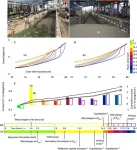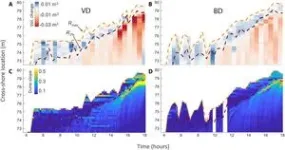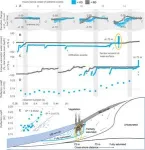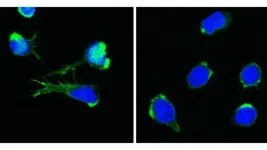(Press-News.org) INTRODUCTION
Coastal sand dunes provide the first line of defense from storms for some of the most economically valuable and ecologically important landscapes in the world (1–3). A current and broadly accepted paradigm is that vegetation reduces the erosion of these dunes during wave attack (4–7). The existing body of dune research shows that a greater size (8), density (9–11), and diversity (12) of plants are associated with less erosion, although these studies have been limited to the investigation of relatively small wave events over short time scales (over minutes). Here, we show that during an extreme storm event, vegetation surprisingly accelerates erosion. While vegetation initially creates a physical barrier to wave energy, it also (i) decreases wave run-up, which creates discontinuities in erosion and accretion patterns across the dune slope, (ii) increases water penetration into the sediment bed, which induces destabilization, and (iii) reflects wave energy, which accelerates scarp formation. These findings fundamentally alter our current understanding of how natural features may provide protection during extreme events.
To test the erosion of vegetated dunes (VDs) against bare dunes (BDs) in a controlled laboratory setting, where all other confounding variables could be removed, we constructed 70-m-long × 4.5-m-high beach-dune profiles and subjected them to waves in a 104-m-long flume. The profile geometry, sedimentary characteristics, and hydrodynamics were carefully constructed and monitored to mimic the progression of real storm events over time (Fig. 1, A and B; see Materials and Methods, figs. S1 to S7, and table S1). Panicum amarum, a typical dune plant common to North America, was grown in situ within the flume for 6 months before the experiment. The individual plant characteristics matched those encountered in the field, and the overall plant density and biomass were similar to those found on restored dunes or the lower portions of natural dunes that encountered frequent wave attack (figs. S8 to S10). Once the experiment began, we recorded the real-time evolution of the dune profiles (figs. S4 and S11 to S13) with an array of sensors and at 0.01-m spatial resolution with terrestrial laser scanners (TLSs).
RESULTS
We found that both the VD and bare BD profiles evolved similarly during the early stages of a storm, until the waves first encountered vegetation, 4.0 hours into the event (Fig. 1, C and D). Shortly thereafter, VD formed an initial erosional scarp at 7.9 hours and had faster profile evolution as compared to BD. The vertical scarp was fully formed by 14.4 hours on VD, several hours earlier than on BD at 17.8 hours. By the peak of storm conditions, at 18.4 hours, the VD scarp was farther landward and nearly twice as high as that of BD (0.79 m versus 0.46 m in scarp height).
The final erosional volume, summed up until the peak conditions occurred, was 22% greater for VD compared with BD (Fig. 1, E and F). The cumulative erosion rates of the dunes diverged as the scarp began to form on VD at 7.9 to 14.4 hours, and there was over twice as much erosion on VD as BD by the end of this period (0.65 versus 0.30 m3 per meter alongshore). This difference was briefly narrowed just before 16.0 hours. Then, a second divergence in cumulative erosion rates occurred between 16.0 and 17.8 hours, after a fully vertical scarp was formed in VD and before any scarp formation in BD. However, once the BD scarp formation was underway, at 17.8 hours, the incremental erosional volume and cumulative erosion rates became more similar between VD and BD.
We identified three hydrodynamic mechanisms that led to the erosional differences between VD and BD. Each mechanism was altered by the presence of vegetation on VD and affected the other two through positive morphodynamic feedback.
First, we observed that the cross-shore excursion distance of the maximum wave run-up (Rmax) was over 10 times less variable for VD as compared to BD, during the first 11.3 hours (Fig. 2, A and B). For VD, the Rmax distance was nearly constant during this time, intercepting the dune at a cross-shore distance of 75 m (SD = 0.08 m). For BD, the Rmax distance ranged from 74 to 76 m (SD = 0.89 m). We also observed that the cross-shore excursion distance of the R2% wave run-up (R2% is the elevation that the largest 2% of all waves exceeded) was shorter for VD during this time, on average.
There was also more fine-scale variation in the VD slope at, and immediately offshore of, the Rmax distance relative to BD (Fig. 2, C and D). Heterogeneous and localized slope discontinuities on the dune surface with a grade greater than 30%, or “micro-slope” features, first appeared at the Rmax distance at 5.0 hours for VD. These first micro-slopes were colocated with mixed accretional-erosional hotspots, where individual run-up waves had removed sand from below R2% and then deposited it before reaching Rmax as they lost momentum and reached their cross-shore limit. By 11.3 hours, erosion seaward of both the Rmax and R2% lines began migrating shoreward and upslope as the storm progressed and the mean water level rose (as depicted by the lightening from dark blue to lighter blue colors, and eventually into micro-slopes, as depicted by the yellow colors). Micro-slopes were much less pronounced on BD, as the run-up and swash redistributed the sand over a broader range of the dune profile.
Second, the vegetation on VD (and its induced micro-slopes) concentrated the run-up water volume into a smaller volume of sand, which precipitated greater profile steepening and micro-slope instability (Fig. 3, A to C). At least initially, the consistently retarded run-up distances on VD kept the sand in the vegetated region of VD drier than that of BD, for the same cross-shore location. However, once the run-up passed this location and was retarded farther upslope, the water rapidly infiltrated and the volumetric water content increased on VD. In effect, the run-up water volume had been concentrated into a smaller volume of sand by the vegetation. Once the volumetric water content at the near surface began to exceed that at greater depths, the dune sands were increasingly poised for instability (see figs. S12 and S13).
Third, wave reflection was increased by the vegetation and its induced micro-slopes (Fig. 3, D to F). As soon as the waves intercepted the vegetated region of VD, at 4.0 hours, offshore wave reflection became greater on VD than on BD. Throughout the evolving storm conditions, the reflection was consistently 3% higher on VD (across the varying dune slope, wave height, and wave period combinations, as recorded by a range of Iribarren numbers, ξ = 0.37 to 0.44 among both VD and BD; linear regression fit for each as VD = 1.4x − 0.4, R2 = 0.42; BD = 1.3x − 0.3, R2 = 0.55).
Silva et al. (9) attributed a similar 4% increase in reflection to vegetation for ξ = 0.4, due to increased friction within the water column, but did not relate it to increased erosion. Reflection rapidly increased at 11.3 hours, as the micro-slopes accumulated and the scarp quickly steepened.
By 14.4 hours into the storm, a small and initial scarp 0.1 m in height was formed on VD (purple line at 76.5 m in Fig. 4A, and as also shown as the transition from bright green to yellow colors at ~76.5 m in Fig. 2C), and erosion accelerated as the beach-dune profile transitioned from a swash regime to a wave collision regime (Fig. 4, B to D). The dune was then undercut laterally, and the gravity-driven processes of scarp slumping began (13, 14), causing erosion in relatively large failure events. By this time frame, the eroded sediment had begun to accumulate into a ~6-m-wide underwater bar within the flume, with its peak ~28 m from the original dune toe. The waves were then more hindered by water depth limitations and impacted the profile with greater prior energy dissipation. This negative feedback loop of scarp slumping, nearshore bar growth, and decreased-intensity wave impact happened earlier on VD, potentially explaining how VD and BD became more similar toward the end of the experiment.
In our experiments, transition to the collision regime on VD began at 7.9 hours and there was a fully vertical scarp by 14.4 hours. In contrast, a wave swash regime existed on BD for much longer, with a transition to collision occurring at 15.5 hours and with a fully vertical scarp at 17.8 hours. In sum, the collision regime on VD persisted for a longer period of time than on BD (11.1 hours versus 3.5 hours, before the peak of the storm conditions), accounting for the greater cumulative erosion.
DISCUSSION
On the basis of the principal finding of this study, coastal engineers and managers may need to reexamine the predominant paradigm that dune vegetation reduces erosion during extreme events. As previous literature (including our own work) suggests, vegetation initially reduces the erosion caused by small waves over short time scales (minutes). However, as we show here, on planted and restored dunes, vegetation actually accelerates erosion over the course of an entire storm by inducing an earlier transition to a collision regime. In essence, dune vegetation disrupts the morphodynamic balance, tipping it toward the creation of micro-slopes and vertical instability.
Accordingly, engineers may need to further explore the assumptions that support models such as XBEACH (15) and CSHORE (16), which are used to design shoreline protection projects around the world (17). In these models, the vegetative roughness-induced friction and drag at fine spatiotemporal scales (e.g., 18–20) have been assumed to raise the water velocity threshold required for sediment mobilization to begin. While this effect reduces erosion to the aft of a plant, the broader concept is that vegetative structure can also induce scouring and supersaturation in front or to the side of the plants (21), creating spatially heterogeneous accretion and erosion patterns (5) and micro-slopes. To progress with these models, fine-scale physics and hydraulics must be better synchronized with the morphodynamic tipping points that delimit the erosional regimes of Sallenger (13)—without the assumption that vegetative structure always reduces erosion at coarser time scales.
Still, we contend that the value of planting vegetation for coastal protection can be gained in the years to decades before a single storm event—and this value is related to the ecological function of the plants rather than their biophysical structure alone (22). While sand can accumulate around any living or nonliving structure, native dune plants grow in size, replicate, and are stimulated by burial. Moreover, the linked ecogeomorphic process of succession acts at the landscape scale over longer time frames to control the shape of the dunes (23). The unique ecological function of living materials includes the ability to physiologically adapt to dynamic storm conditions, create spatially heterogeneous erosion and accretion patterns with a diverse array of plant species that fill several niches at the landscape scale, and continue to migrate landward and provide ecosystem services as the sea level rises globally—all of which help build the dunes. If vegetation is absent or unhealthy over the years before a storm, the dunes will be smaller when the storm hits and the damage to landward locations will be greater.
Historically, many coastal managers have assumed that the physiological aim of vegetation is to stabilize the sand during extreme events (24). Our results provide initial evidence that this assumption is incorrect, and we contend that the assumption has had negative consequences for coastal protection efforts. For example, after the 2004 Indian Ocean tsunami and the 2011 Tōhoku tsunami, nongovernmental organizations (NGOs) and government agencies planted nonnative Casuarina equisetifolia trees across large areas of the coast, believing that their structure will protect the coast during future extreme events. However, these policies ultimately increased erosion over longer time scales by replacing native plants, which led to less dune accretion and lower elevations (24). A similar story has played out with the use of various Ammophila, Spartina, Oenothera, and Tamarix species for stabilization projects around the world over the past century [e.g., (25)]. As shown here, an attempt to stabilize a dune based on a narrow view of vegetative structure will only accelerate its loss during an extreme storm event. Rather, coastal managers should select an appropriate species based on their ecological function to build the dunes in the years before the event occurs.
Although we tested the effect of only one species here, P. amarum, there is no reason to believe that the results would be qualitatively different given another species. Fundamentally, any living or nonliving structure that is placed onto the beach-dune profile will create a discontinuity in wave run-up and energy flow across the landscape. The same three mechanisms of enhanced erosion that we have discussed here will apply, and in fact are likely to be amplified in a case of an even greater plant coverage, biomass, or physical stature.
Moreover, as has been shown in the past by other dune studies, aboveground and belowground stems, stolons, and leaves function similarly under wave attack (5–6) and only fine roots hold onto the sediment in a unique manner (7). Thus, if anything, VD likely yielded an underestimate of the erosion caused by vegetation on the upper portions of real-world dunes covered by P. amarum (as VD was high in fine root biomass, yet low in other types of biomass, as compared to field conditions—see Materials and Methods). For real-world dunes, the key portion of the morphologic sequence that is most affected by vegetation is during the run-up regime and the initiation of scarp formation, which most typically occurs on the lower portions of the dunes where the vegetation densities are relatively lower. For these reasons, we expect that our findings are universalizable in a qualitative manner across all VD types, when they are subjected to extreme events over hours to days of time. We expect that only the absolute quantities of vegetation-induced erosion may differ as based on the specific species or planting densities.
Notably, our experiments did not continue beyond the peak of the simulated storm conditions. We can speculate, however, that the cumulative erosion differences should persist in time for real-world dunes, even after a storm, as the water level draws down and the interaction with vegetative structure ceases. We also note that the induced storm conditions were not designed to approximate a given spectrum of infragravity motion at dune toe, but rather to match the spectrum within the inner surf zone, based on a modeled dataset (figs. S1 and S2). However, wave transformation and reflection between these two positions in the bounded flume likely inserted somewhat similar motion, and the Rmax and R2% statistics appeared to be generally consistent with real-world datasets.
In summary, we found that the net effect of planted dune vegetation was to increase erosion during extreme events. Vegetation creates a physical barrier that shortens the length of maximum wave run-up, alters accretion and erosion patterns, and creates steep micro-slopes. Compared to bare dunes, vegetated dunes concentrate the same volume of water into a smaller volume of sand, which then predisposes the dune to fluidization and micro-slope formation, wave reflection, earlier scarp formation, and more rapid dune erosion over the course of a storm.
END
New research shows vegetation accelerates coastal dune erosion during extreme events
These findings fundamentally alter our current understanding of how natural features may provide protection during extreme events
2023-06-21
ELSE PRESS RELEASES FROM THIS DATE:
Inside-out heating and ambient wind could make direct air capture cheaper and more efficient
2023-06-21
What started as a simple errand to deposit a check at a bank drive-through became the kind of “aha” moment found mostly in books and movies.
Georgia Tech researchers had been working on an idea to simplify traditional direct air capture (DAC) systems. Their approach used ambient wind flow to draw air across a new kind of coated carbon fiber to grab CO2. That would eliminate the loud fans used in many systems. And the carbon fiber strands could be quickly heated to release the captured carbon dioxide with ...
A clean energy transition is possible for China’s manufacturing industry
2023-06-21
The industrial sector – made up of businesses that support processing raw materials for manufacturing and consumer goods – is a major contributor to greenhouse gas emissions and one that has proven difficult to decarbonize. In China, much of the industrial sector is organized into ‘parks’ that have been zoned as areas for concentrated industrial activities. China has more than 2,500 industrial parks that are currently largely powered by coal. A recent study led by researchers at Princeton University finds that this clustering of industry provides unique and overlooked opportunities for targeted energy supply emissions reduction ...
Antarctic ice shelves experienced only minor changes in surface melt since 1980
2023-06-21
Antarctic ice shelves have experienced only minor changes in surface melt rates over the past four decades, unlike the rapid increase in surface melt experienced by Greenland’s glaciers during the same time period, according to new research. The news is not cause for celebration just yet, though—the researchers expect Antarctic ice shelf surface melt rates to increase substantially in the coming decades due to rising global air temperatures.
Ice shelves are the parts of glaciers that extend into the ocean and float on top of seawater. In a new study published today in Geophysical Research Letters, glaciologists ...
Hastings Center partners on AI project led by national academies
2023-06-21
The National Academy of Medicine (NAM) is partnering with a group of leading health, bioethics, equity, tech, patient advocacy, and research organizations, including The Hastings Center, to develop an Artificial Intelligence Code of Conduct (AICC).
Dr. Vardit Ravitsky, incoming president of The Hastings Center, who will serve on the steering committee, said, “we must urgently develop guidance for the ethical use of AI – perhaps the most transformative technology of our generation.” ...
CSU biologists document genome-level climate adaptation in endangered bird species
2023-06-21
As the climate changes, living things must adapt to new environmental conditions in one of two ways – either geographically or genetically. While it’s relatively simple for scientists to track and record a species’ geographic movements, proving their genetic adaptation over time can be much more difficult.
A new study led by Colorado State University researchers in Nature Climate Change is one of the first to document climate adaptation at the genomic level in a wild population. Specifically, the Southwestern Willow Flycatcher – an endangered migratory bird – has shown an increase in genetic variation ...
DNA test could broaden access to cervical cancer screening
2023-06-21
HOUSTON – (June 21, 2023) – Rice University bioengineers have demonstrated a low-cost, point-of-care DNA test for HPV infections that could make cervical cancer screening more accessible in low- and middle-income countries where the disease kills more than 300,000 women each year.
HPV, a family of viruses, infects nearly everyone at some point in their lives, often without symptoms. But more than a dozen types of HPV can cause persistent infections that result in cervical cancer, which is preventable and curable ...
Cancer drugs show potential in fight against malaria
2023-06-21
With malaria becoming increasingly drug-resistant, a team of UCF researchers is looking to use cancer drugs to accelerate the discovery of new life-saving therapies for the disease.
In a study funded by a 5-year $3.8 million grant from the National Institutes of Health, UCF molecular parasitologist Debopam Chakrabarti and cancer molecular biologist Ratna Chakrabarti are partnering with Nathanael Gray, co-leader of the cancer therapeutics research program at Stanford University and Elizabeth Winzeler, a malaria drug development expert from the University of California San Diego, to test cancer drugs for malaria-fighting ...
Newly discovered genetic defect disrupts blood formation and immune system
2023-06-21
(Vienna, 21.06.2023) In the quest to find the origin of the puzzling symptoms in four children, researchers from St. Anna Children's Cancer Research Institute, the CeMM Research Center for Molecular Medicine of the Austrian Academy of Sciences (ÖAW), and the Medical University of Vienna have discovered a completely new disease, linking disruptions of blood formation, the immune system, and inflammation. This groundbreaking discovery provides the basis for a better understanding of similar diseases. It is a milestone that the researchers have now published ...
New study reveals number and strength of head impacts, not concussions, drive CTE risk in football
2023-06-21
Does a football player’s number of concussions drive the risk of developing chronic traumatic encephalopathy (CTE)? In a new study of 631 deceased football players, the largest CTE study to date, scientists found that the number of diagnosed concussions alone was not associated with CTE risk. Instead, football players’ odds of developing CTE were related to both how many head impacts they received and how hard the head impacts were.
The study, conducted by researchers at Mass General Brigham, Harvard Medical School, and Boston University (BU), was published today in Nature Communications. It ...
ASPB Journals launch Author Travel Awards
2023-06-21
ROCKVILLE, MD - Authors whose work has been published in Plant Physiology or The Plant Cell, leading international society journals published by the American Society of Plant Biologists (ASPB), have a new option to support their travel to share their research with the scientific community. Funded by Plant Physiology and The Plant Cell, US$1,000 travel awards will be awarded to authors who have received invitations to give an oral presentation at any conference or scientific meeting around the world. Five US$1,000 awards are available in 2023 with more awards anticipated for 2024 ...
LAST 30 PRESS RELEASES:
Red light therapy shows promise for protecting football players’ brains
Trees — not grass and other greenery — associated with lower heart disease risk in cities
Chemical Insights scientist receives Achievement Award from the Society of Toxicology
Breakthrough organic crystalline material repairs itself in extreme cold temperatures, unlocking new possibilities for space and deep-sea technologies
Scientists discover novel immune ‘traffic controller’ hijacked by virus
When tropical oceans were oxygen oases
Positive interactions dominate among marine microbes, six-year study reveals
Safeguarding the Winter Olympics-Paralympics against climate change
Most would recommend RSV immunizations for older and pregnant people
Donated blood has a shelf life. A new test tracks how it's aging
Stroke during pregnancy, postpartum associated with more illness, job status later
American Meteorological Society announces new executive director
People with “binge-watching addiction” are more likely to be lonely
Wild potato follows a path to domestication in the American Southwest
General climate advocacy ad campaign received more public engagement compared to more-tailored ad campaign promoting sustainable fashion
Medical LLMs may show real-world potential in identifying individuals with major depressive disorder using WhatsApp voice note recordings
Early translational study supports the role of high-dose inhaled nitric oxide as a potential antimicrobial therapy
AI can predict preemies’ path, Stanford Medicine-led study shows
A wild potato that changed the story of agriculture in the American Southwest
Cancer’s super-enhancers may set the map for DNA breaks and repair: A key clue to why tumors become aggressive and genetically unstable
Prehistoric tool made from elephant bone is the oldest discovered in Europe
Mineralized dental plaque from the Iron Age provides insight into the diet of the Scythians
Salty facts: takeaways have more salt than labels claim
When scientists build nanoscale architecture to solve textile and pharmaceutical industry challenges
Massive cloud with metallic winds discovered orbiting mystery object
Old diseases return as settlement pushes into the Amazon rainforest
Takeaways are used to reward and console – study
Velocity gradients key to explaining large-scale magnetic field structure
Bird retinas function without oxygen – solving a centuries-old biological mystery
Pregnancy- and abortion-related mortality in the US, 2018-2021
[Press-News.org] New research shows vegetation accelerates coastal dune erosion during extreme eventsThese findings fundamentally alter our current understanding of how natural features may provide protection during extreme events







